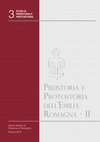Papers by Marinella Marchesi
I pittori di Pompei. Affreschi romani dal Museo Archeologico Nazionale di Napoli, cat. della mostra a cura di M. Grimaldi (Bologna 2022-2023), 2022
, l'U cio Protocollo, i Coordinatori della Vigilanza e tutto il personale del MANN.
Berengario da Carpi. Il medico del Rinascimento, Catalogo della Mostra, Carpi, 14 settembre-16 dicembre 2018, 2018

Gli Etruschi nella Valle del Po, Atti del XXX Convegno di Studi Etruschi ed Italici (Bologna, 23-25 giugno 2022), 2024
Set beyond the southeastern borders of the settlement of Felsina, the Arsenale Militare burial gr... more Set beyond the southeastern borders of the settlement of Felsina, the Arsenale Militare burial ground represents one of the most important burial areas of the Orientalizing age excavated in Bologna during the 19th century. However, the type of use of the area, occupied by one of the most active government pyrotechnic laboratories in post-Unification Italy, made the archaeological activities very difficult and discontinuous. The explorations and discoveries of 1874-1916 have been only minimally published, while they are well-documented in the archival documents preserved in the Historical Archives of the Archaeological Museum of Bologna, which also
preserves about 700 objects from the necropolis. The paper focuses on reconstructing, through this documentation, the extent of the burial ground, its articulation and the chronology of its frequentation, providing a preliminary picture of the structural characteristics of the depositions and
the composition of the grave goods.
DOAJ (DOAJ: Directory of Open Access Journals), Dec 1, 2018
Un sentito ringraziamento a Giuseppe Capriotti per l'invito ad intervenire al seminario in memori... more Un sentito ringraziamento a Giuseppe Capriotti per l'invito ad intervenire al seminario in memoria di Claudia Giontella e a Pierluigi Feliciati, insieme ai docenti del Dipartimento di Scienze della Formazione, dei beni culturali e del turismo, per l'affettuosa accoglienza a Macerata.
Etruschi. Viaggio nelle terre dei Rasna, Catalogo della mostra (Bologna Museo Civico Archeologico 7 dicembre 2019 – 24 maggio 2020), Milano 2019, 2019
Virtual Archaeology Review, 2012
Resumen El proyecto de "Marcus Caelius, el valor de la memoria" es una breve película de animació... more Resumen El proyecto de "Marcus Caelius, el valor de la memoria" es una breve película de animación de 8 minutos ambientada en la Bolonia romana (Bononia) durante el periodo del emperador Augusto, que surge de una iniciativa del Museo Arqueológico de Bolonia, en colaboración con Cineca. Este proyecto, basado en un famoso hecho histórico (la batalla de Teutoburgo), quiere proponer un enfoque filológico dentro de un proceso emocional/narrativo, definiendo una pipeline de producción apropiada (que incluye renderizado de Blender, Chroma key y animación Machinima) para definir tiempo y costes que puedan ser cubiertos por un pequeña producción. Nuevas reconstrucciones filológicamente adecuadas (restos arqueológicos en la Colección del Museo), se integran dentro de sets en 3D que proceden de proyectos anteriores de Cineca.
The Archaeological Museum of Bologna has tested the application of digital technologies on some o... more The Archaeological Museum of Bologna has tested the application of digital technologies on some objects within the project "D12", aimed to connect 3D documentation with polychromy data. An Etruscan stela from Bologna, called “Ducati 12”, gives its name to the project. 3D scanning tests made on some Etruscan artifacts within the project prove that nowadays archaeological and artistic material can be investigated through a low-cost, time-saving and reliable approach. Several 3D virtual data digital technologies were tested and after the postprocessing treatment some real applications on 3D data were realized. Multispectral and chemichal investigations were carried out on the objects. The results achieved allow to undertake an effective research project for the reconstruction of the polychromy in Etruscan age.
I. Bianchi, G. Paolucci (a cura di), Collezionisti, accademie, musei: storie del mondo etrusco dal XVI al XIX secolo, Interventi dal convegno internazionale "La tradizione etrusca e il collezionismo in Europa dal XVI al XIX secolo" (Pisa 2014-2016), Milano 2020, pp. 148-161., 2020
Fac-simile 1: le collezioni di documentazione grafica sulla pittura etrusca – Varia, MEFRA Antiquité 131-2, 2019
“Better than any description they make know the uses”: the Gallery of Etruscan paintings in the A... more “Better than any description they make know the uses”: the Gallery of Etruscan paintings in the Archaeological Museum of Bologna. The reproductions of Etruscan paintings spread over the walls of the vast hall dedicated to the Etruscan antiquities in the Archaeological Museum of Bologna, already widely analysed, are reconsidered following a revision of the archival documentation and a thorough re-reading of the variegated work of the Bolognese painter Luigi Busi, their maker. Some interesting news about museographic contextualization and methods of planning and realization of the pictorial cycle are presented.

H. Baitinger, M. Schönfelder (Hrsg.), Hallstatt und Italien. Festschift für Markus Egg, Mainz 2019, pp. 399-429, 2019
An Unpublished Complex from San Giovanni in Persiceto (prov. Bologna).
Revisions and Reflections ... more An Unpublished Complex from San Giovanni in Persiceto (prov. Bologna).
Revisions and Reflections on Open-handle Hemispherical Drawers
The analysis of two handles belonging to two bronze cups, very different in shape, found in a male incineration tomb in San Giovanni in Persiceto, attributable to the Villanoviano IV, and now kept in Karlsruhe, leads to a re-examination of the class of hemispherical drawers with an open handle, a peculiar product of Etruscan
Bologna toreutics. After a brief reference to the history of the studies, the article proposes a typological classification of the 184 specimen identified in the course of a comprehensive review of objects conserved in the Museo Civico Archeologico of Bologna and published so far. Finally, a discussion of the most interesting associations with other significant elements of the grave furnishings and some preliminary considerations on the original use of this particular type of vase follows.

M. Bernabò Brea (a cura di), Preistoria e Protostoria dell’Emilia-Romagna II, Atti della XLV Riunione Scientifica dell’Istituto Italiano di Preistoria e Protostoria (Modena, 27-31 ottobre 2010), Firenze 2018, pp. 291-298., 2018
The Arnoaldi necropolis of Bologna. Preliminary topographical and chronological description withi... more The Arnoaldi necropolis of Bologna. Preliminary topographical and chronological description within the final phases of the Bologna Villanovan period – The review of the complex, but unfortunately incomplete, documentation relating to the excavation of the Villanovan tombs in the Arnoaldi necropolis of Bologna, explored between 1872 and 1884, has led to some novelties concerning the number of graves, the topography of the cemetery, the variety of structures and the funeral rites. A first comparison between written records and materials, kept sorted by type, has permitted the reconstruction of some grave goods and an attempt at a chronological seriation of depositions.
Il Capitale culturale, 2018
We publish here the speech, reviewed by the author, presented on the 18th of April 2018 at the se... more We publish here the speech, reviewed by the author, presented on the 18th of April 2018 at the seminar in honor of Claudia Giontella. The Etruscan paintings reproductions spread over the walls of the vast hall dedicated to the Etruscan antiquities in the Archaeological Museum of Bologna, already widely analysed, are reconsidered both in relation to previous similar museographic experiences and following a revision of the archival documentation and a thorough re-reading of the variegated work of the Bolognese painter Luigi Busi, their maker. Some interesting ideas about museographic purposes and contextualization, as well
as methods of planning and realization of the pictorial cycle are presented.
Lema: Documentación 3D avanzada, modelado y reconstrucción de objetos patrimoniales, monumentos y... more Lema: Documentación 3D avanzada, modelado y reconstrucción de objetos patrimoniales, monumentos y sitios.

proceeding of III Congreso Internacional de Arqueología e Informática Gráfica, Patrimonio e Innovación Sevilla 22-24 de Junio de 2012 , Jun 2012
El proyecto de "Marcus Caelius, el valor de la memoria" es una breve película de animación de 8 m... more El proyecto de "Marcus Caelius, el valor de la memoria" es una breve película de animación de 8 minutos ambientada en la Bolonia romana (Bononiae) durante el periodo del emperador Augusto, que surge de una iniciativa del Museo Arqueológico de Bolonia, en colaboración con CINECA. Este proyecto, basado en un famoso hecho histórico (la batalla de Teutoburgo), quiere proponer un enfoque filológico dentro de un proceso emocional/narrativo, definiendo una pipeline de producción apropiada (que incluyen renderizado di Blender, Chroma key y animación Machinima) para definir tiempo y costes que puedan ser cubiertos por un pequeña producción. Nuevas reconstrucciones filológicamente adecuadas (restos arqueológicos en la Colección del Museo), se integran dentro de sets en 3D que proceden de proyectos anteriores de Cineca.











Uploads
Papers by Marinella Marchesi
preserves about 700 objects from the necropolis. The paper focuses on reconstructing, through this documentation, the extent of the burial ground, its articulation and the chronology of its frequentation, providing a preliminary picture of the structural characteristics of the depositions and
the composition of the grave goods.
Revisions and Reflections on Open-handle Hemispherical Drawers
The analysis of two handles belonging to two bronze cups, very different in shape, found in a male incineration tomb in San Giovanni in Persiceto, attributable to the Villanoviano IV, and now kept in Karlsruhe, leads to a re-examination of the class of hemispherical drawers with an open handle, a peculiar product of Etruscan
Bologna toreutics. After a brief reference to the history of the studies, the article proposes a typological classification of the 184 specimen identified in the course of a comprehensive review of objects conserved in the Museo Civico Archeologico of Bologna and published so far. Finally, a discussion of the most interesting associations with other significant elements of the grave furnishings and some preliminary considerations on the original use of this particular type of vase follows.
as methods of planning and realization of the pictorial cycle are presented.
preserves about 700 objects from the necropolis. The paper focuses on reconstructing, through this documentation, the extent of the burial ground, its articulation and the chronology of its frequentation, providing a preliminary picture of the structural characteristics of the depositions and
the composition of the grave goods.
Revisions and Reflections on Open-handle Hemispherical Drawers
The analysis of two handles belonging to two bronze cups, very different in shape, found in a male incineration tomb in San Giovanni in Persiceto, attributable to the Villanoviano IV, and now kept in Karlsruhe, leads to a re-examination of the class of hemispherical drawers with an open handle, a peculiar product of Etruscan
Bologna toreutics. After a brief reference to the history of the studies, the article proposes a typological classification of the 184 specimen identified in the course of a comprehensive review of objects conserved in the Museo Civico Archeologico of Bologna and published so far. Finally, a discussion of the most interesting associations with other significant elements of the grave furnishings and some preliminary considerations on the original use of this particular type of vase follows.
as methods of planning and realization of the pictorial cycle are presented.
L’esposizione Libia 1911-1912. Colonialismo e collezionismo, consente di entrare in contatto con vicende belliche che determinarono l’espansione coloniale italiana fino alla fine della Seconda Guerra Mondiale e permette di conoscere le traiettorie del collezionismo coloniale in Italia e in Europa, con riferimento specifico al contributo di cittadini bolognesi. La raccolta libica della Croce Rossa di Bologna, conservata presso il Museo Civico del Risorgimento cittadino e riscoperta nell’ultimo scorcio del Ventesimo secolo, recupera la memoria della guerra italo-turca, un importante episodio del colonialismo italiano postunitario in Africa. Fotografie e oggetti raccolti in Libia dai membri della 47° Ambulanza e conservate in altre raccolte documentarie del Museo del Risorgimento, raccontano le caratteristiche peculiari del collezionismo coloniale. Con riferimento al più ampio contesto della penetrazione europea nell’Africa settentrionale, l’allestimento è arricchito dai materiali della collezione di Carlo Mazzetti, bolognese che visse per oltre cinquant’anni in Egitto a partire dal 1849 e che inviò nella città natale oggetti prelevati dai campi di battaglia delle guerre anglo-egiziana e anglo-mahdista. Il patrimonio donato da Mazzetti, oggi conservato nei depositi del Museo Civico Medievale e in mostra fin dall’allestimento del Museo Civico di Bologna deciso nel 1881, fu confermato nei suoi successivi adattamenti, risalenti all’inizio del XX secolo, quando una vetrina dedicata alle guerre coloniali in Egitto fu aggiunta all’esposizione. Le raccolte, messe tra loro in dialogo nel contesto della mostra Libia 1911-1912, riportano alla luce documenti eccezionali mai pubblicati prima, utili per arricchire la conoscenza storica degli eventi storici che hanno contraddistinto l’espansione coloniale europea nell’Africa settentrionale.
del Museo Civico Archeologico di Bologna, già oggetto di precedenti articolati studi, vengono riconsiderate sia in relazione alle precedenti simili esperienze museografiche sia a seguito di una revisione della documentazione d’archivio e di una rilettura approfondita della variegata opera pittorica dell’artista bolognese Luigi Busi, loro artefice. Da ciò derivano alcuni interessanti spunti rispetto alla contestualizzazione e alle finalità museografiche, nonché alle modalità di progettazione e realizzazione del ciclo pittorico.
We publish here the speech, reviewed by the author, presented on the 18th of April 2018 at the seminar in honor of Claudia Giontella. The Etruscan paintings reproductions spread over the walls of the vast hall dedicated to the Etruscan antiquities in the Archaeological Museum of Bologna, already widely analysed, are reconsidered both in relation to previous similar museographic experiences and following a revision of the archival documentation and a thorough re-reading of the variegated work of the Bolognese painter Luigi Busi, their maker. Some interesting ideas about museographic purposes and contextualization, as well
as methods of planning and realization of the pictorial cycle are presented.